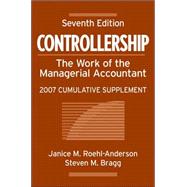
Steven M. Bragg, CPA, CMA, CIA, CPIM, has been the chief financial officer or controller of four companies, as well as a consulting manager at Ernst & Young and auditor at Deloitte. He received a master’s degree in finance from Bentley College, an MBA from Babson College, and a bachelor’s degree in economics from the University of Maine. He has been the two-time president of the 10,000-member Colorado Mountain Club, and is an avid alpine skier, mountain biker, and rescue diver.
| Preface | xiii | ||||
| PART 1 THE BROAD MANAGEMENT ASPECTS OF CONTROLLERSHIP | |||||
|
3 | (2) | |||
|
3 | (2) | |||
|
5 | (6) | |||
|
5 | (1) | |||
|
6 | (5) | |||
| PART 2 THE PLANNING FUNCTION OF CONTROLLERSHIP | |||||
|
11 | (6) | |||
|
11 | (1) | |||
|
12 | (5) | |||
| PART 3 PLANNING AND CONTROLLING OPERATIONS | |||||
|
|||||
|
17 | (3) | |||
|
20 | (3) | |||
|
20 | (3) | |||
|
23 | (3) | |||
|
23 | (1) | |||
|
24 | (2) | |||
|
26 | (5) | |||
|
26 | (5) | |||
|
31 | (2) | |||
|
31 | (2) | |||
|
33 | (12) | |||
|
33 | (7) | |||
|
40 | (5) | |||
| PART 4 PLANNING AND CONTROL OF THE BALANCE SHEET | |||||
|
45 | (2) | |||
|
45 | (1) | |||
|
46 | (1) | |||
|
47 | (2) | |||
|
49 | (39) | |||
|
49 | (1) | |||
|
50 | (18) | |||
|
68 | (11) | |||
|
79 | (1) | |||
|
79 | (4) | |||
|
83 | (2) | |||
|
85 | (1) | |||
|
86 | (2) | |||
|
88 | (25) | |||
|
88 | (1) | |||
|
89 | (2) | |||
|
91 | (3) | |||
|
94 | (3) | |||
|
97 | (2) | |||
|
99 | (3) | |||
|
102 | (1) | |||
|
103 | (3) | |||
|
106 | (3) | |||
|
109 | (1) | |||
|
110 | (3) | |||
| PART 5 FINANCIAL AND RELATED REPORTS | |||||
|
113 | (6) | |||
|
113 | (1) | |||
|
114 | (1) | |||
|
115 | (2) | |||
|
117 | (2) | |||
|
119 | (6) | |||
|
119 | (6) | |||
|
125 | (2) | |||
|
125 | (1) | |||
|
126 | (1) | |||
|
127 | (6) | |||
|
127 | (6) | |||
| PART 6 COMPUTER SYSTEMS AND RELATED TECHNOLOGY | |||||
|
133 | (6) | |||
|
133 | (1) | |||
|
134 | (1) | |||
|
134 | (2) | |||
|
136 | (1) | |||
|
137 | (2) | |||
|
139 | (4) | |||
|
139 | (1) | |||
|
139 | (1) | |||
|
140 | (2) | |||
|
142 | (1) | |||
|
143 | (10) | |||
|
143 | (2) | |||
|
145 | (2) | |||
|
147 | (3) | |||
|
150 | (2) | |||
|
152 | (1) | |||
|
153 | (6) | |||
|
153 | (1) | |||
|
154 | (1) | |||
|
155 | (1) | |||
|
155 | (1) | |||
|
156 | (3) | |||
| PART 7 SOME ADMINISTRATIVE AND SPECIAL ASPECTS OF THE CONTROLLER'S DEPARTMENT | |||||
|
159 | (6) | |||
|
159 | (1) | |||
|
160 | (1) | |||
|
161 | (2) | |||
|
163 | (2) | |||
|
165 | (5) | |||
|
165 | (1) | |||
|
166 | (3) | |||
|
169 | (1) | |||
|
170 | (5) | |||
|
170 | (1) | |||
|
171 | (2) | |||
|
173 | (2) | |||
|
175 | (5) | |||
|
175 | (1) | |||
|
176 | (1) | |||
|
177 | (2) | |||
|
179 | (1) | |||
|
180 | (6) | |||
|
180 | (1) | |||
|
181 | (4) | |||
|
185 | (1) | |||
|
186 | (1) | |||
|
186 | (1) | |||
|
187 | (16) | |||
|
187 | (14) | |||
|
201 | (2) | |||
|
203 | (3) | |||
|
203 | (1) | |||
|
204 | (1) | |||
|
205 | (1) | |||
|
206 | (7) | |||
|
206 | (1) | |||
|
207 | (2) | |||
|
209 | (4) | |||
| Index | 213 |
The New copy of this book will include any supplemental materials advertised. Please check the title of the book to determine if it should include any access cards, study guides, lab manuals, CDs, etc.
The Used, Rental and eBook copies of this book are not guaranteed to include any supplemental materials. Typically, only the book itself is included. This is true even if the title states it includes any access cards, study guides, lab manuals, CDs, etc.